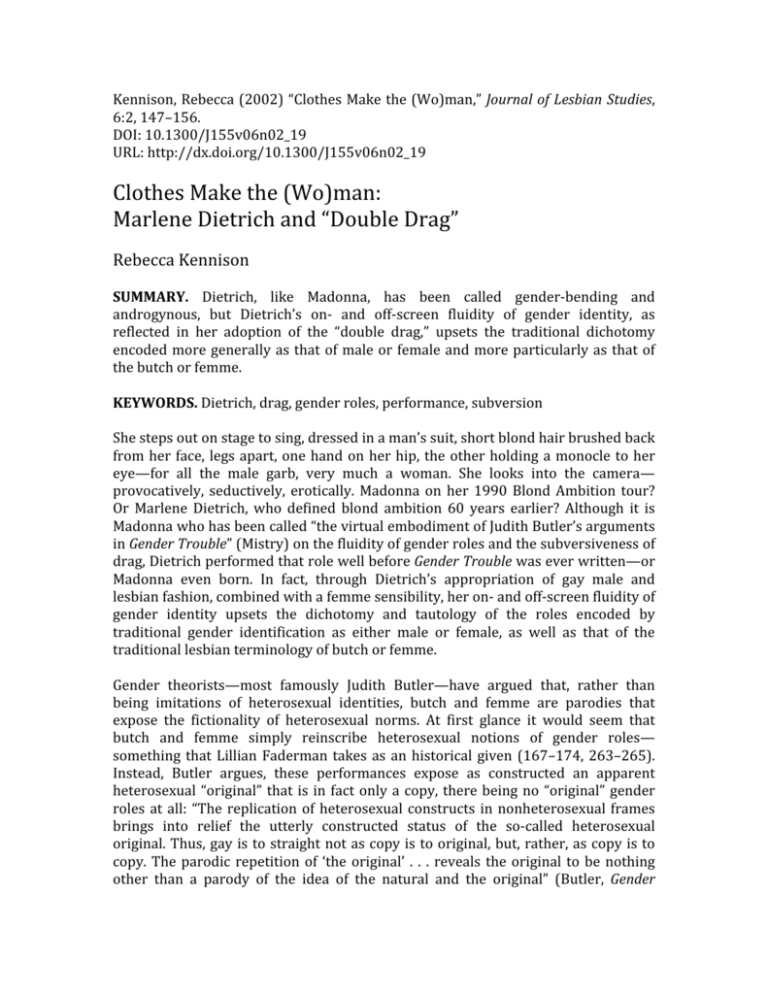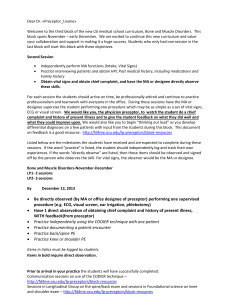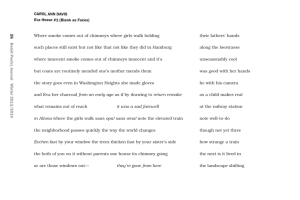
Kennison,
Rebecca
(2002)
“Clothes
Make
the
(Wo)man,”
Journal
of
Lesbian
Studies,
6:2,
147–156.
DOI:
10.1300/J155v06n02_19
URL:
http://dx.doi.org/10.1300/J155v06n02_19
Clothes
Make
the
(Wo)man:
Marlene
Dietrich
and
“Double
Drag”
Rebecca
Kennison
SUMMARY.
Dietrich,
like
Madonna,
has
been
called
gender‐bending
and
androgynous,
but
Dietrich’s
on‐
and
off‐screen
fluidity
of
gender
identity,
as
reflected
in
her
adoption
of
the
“double
drag,”
upsets
the
traditional
dichotomy
encoded
more
generally
as
that
of
male
or
female
and
more
particularly
as
that
of
the
butch
or
femme.
KEYWORDS.
Dietrich,
drag,
gender
roles,
performance,
subversion
She
steps
out
on
stage
to
sing,
dressed
in
a
man’s
suit,
short
blond
hair
brushed
back
from
her
face,
legs
apart,
one
hand
on
her
hip,
the
other
holding
a
monocle
to
her
eye—for
all
the
male
garb,
very
much
a
woman.
She
looks
into
the
camera—
provocatively,
seductively,
erotically.
Madonna
on
her
1990
Blond
Ambition
tour?
Or
Marlene
Dietrich,
who
defined
blond
ambition
60
years
earlier?
Although
it
is
Madonna
who
has
been
called
“the
virtual
embodiment
of
Judith
Butler’s
arguments
in
Gender
Trouble”
(Mistry)
on
the
fluidity
of
gender
roles
and
the
subversiveness
of
drag,
Dietrich
performed
that
role
well
before
Gender
Trouble
was
ever
written—or
Madonna
even
born.
In
fact,
through
Dietrich’s
appropriation
of
gay
male
and
lesbian
fashion,
combined
with
a
femme
sensibility,
her
on‐
and
off‐screen
fluidity
of
gender
identity
upsets
the
dichotomy
and
tautology
of
the
roles
encoded
by
traditional
gender
identification
as
either
male
or
female,
as
well
as
that
of
the
traditional
lesbian
terminology
of
butch
or
femme.
Gender
theorists—most
famously
Judith
Butler—have
argued
that,
rather
than
being
imitations
of
heterosexual
identities,
butch
and
femme
are
parodies
that
expose
the
fictionality
of
heterosexual
norms.
At
first
glance
it
would
seem
that
butch
and
femme
simply
reinscribe
heterosexual
notions
of
gender
roles—
something
that
Lillian
Faderman
takes
as
an
historical
given
(167–174,
263–265).
Instead,
Butler
argues,
these
performances
expose
as
constructed
an
apparent
heterosexual
“original”
that
is
in
fact
only
a
copy,
there
being
no
“original”
gender
roles
at
all:
“The
replication
of
heterosexual
constructs
in
nonheterosexual
frames
brings
into
relief
the
utterly
constructed
status
of
the
so‐called
heterosexual
original.
Thus,
gay
is
to
straight
not
as
copy
is
to
original,
but,
rather,
as
copy
is
to
copy.
The
parodic
repetition
of
‘the
original’
.
.
.
reveals
the
original
to
be
nothing
other
than
a
parody
of
the
idea
of
the
natural
and
the
original”
(Butler,
Gender
Trouble
41).
Annika
Thiem
describes
this
as
a
“double
mimesis,”
explaining
that
“the
‘original’
is
rendered
original
in
a
process
.
.
.
where
the
second
mimetic
duplication
functions
to
disavow
precisely
the
mimetic
character.
.
.
.
The
so‐called
copy,
therefore,
could
not
be
[a]
copy
without
the
so‐called
original
and
the
so‐called
original
could
not
be
[an]
original
without
the
copy.”
This
double
mimesis
underscores
the
instability
of
the
very
terms
butch
and
femme,
rendering
both
parodic.
But
even
as
a
parody
of
heterosexual
norms,
whether
intentional
or
not,
appearance
plays
a
large
part
in
a
lesbian’s
perceived
role
as
butch
or
femme—or
as
something
else.
In
Kristin
Esterberg’s
discussion
of
the
importance
of
a
distinctive
look
as
crucial
to
a
performance
of
lesbian
identity
in
general
and
of
butch–femme
roles
in
particular,
she
quotes
one
woman
who
draws
this
connection
between
her
sexual
and
emotional
self‐identity
and
her
appearance:
The
times
I
really
tune
in
to
being
a
lesbian
per
se
are
the
times
that
I
get
caught
up
in
the
role.
You
know,
when
I
see
a
woman
in
a
shirt
and
tie
and
a
leather
jacket.
And
I
go
wild.
Or
the
times
that
I
put
certain
clothes
on,
and
I
am
struck
by
the
effect,
you
know,
whether
it
makes
me
feel
really
butch
or
whether
it
makes
me
feel
really
fem[me].
I’m
often
struck
by
feeling
a
certain
way,
you
know—a
certain
swagger
when
I
walk,
checking
myself
in
the
windows
in
my
sunglasses
and,
you
know,
really
cool
.
.
.
I’d
say,
“Yeah!”
(qtd.
in
Esterberg
265;
italics
in
original)
Clearly
this
woman
would
agree
with
Alisa
Solomon’s
observation
that
“[b]utch
and
femme
are
not
just
the
costume,
but
they’re
nothing
without
the
costume”
(273).
In
this
(in)vested
performance,
most
lesbians
establish
their
own
sense
of
social
norms,
whether
or
not
they
think
of
them
as
parody
of
heterosexual
ones
and
hence
as
some
sort
of
drag
performance.
In
establishing
her
own
norms,
as
neither
solely
butch
nor
only
femme
but
constantly
both,
Dietrich
was,
in
a
sense,
always
in
drag.
She
was
known
both
on‐
and
off‐screen
for
her
“mannish
clothes,”
although
she
soon
discovered
that
what
was
acceptable
onstage
or
on‐screen
was
not
so
readily
accepted
off
it;
she
regularly
scandalized
the
American
and
European
press
in
the
1930s
by
wearing
pants
in
public
(Bach
167,
174;
Faderman
125;
Riva
187,
206–
207).
While
Dietrich
preferred
to
wear
a
“man’s
outfit
of
sports
jacket,
slouch
hat,
and
tie”
with
trousers
or
(on
rare
occasions)
a
skirt
(Riva
122)
when
offstage
or
off‐
screen,
she
was
equally
well
known
for
her
onstage
gowns,
so
much
so
that
years
later
the
flamboyant
Liberace
compared
his
outfits
to
Dietrich’s
by
commenting,
“For
me
to
wear
a
simple
tuxedo
onstage
would
be
like
asking
Marlene
Dietrich
to
wear
a
housedress”
(Thomas
243;
qtd.
in
Garber
357).
Both
forms
of
attire,
then,
were
a
kind
of
drag
performance,
for
the
public
when
she
wore
men’s
clothing,
for
herself
when
she
did
not.
Even
more
gender‐bending,
especially
on‐screen
and
onstage,
was
Dietrich’s
sly
mix
of
“male”
and
“female”
styles
and
her
subversion
of
gender
roles
to
create
what
she
often
called
an
“interesting”
effect.
For
all
of
Butler’s
insistence
on
drag
as
a
subversion
of
gender
roles
through
its
parodic
imitation
of
those
roles
(Gender
Trouble
174–175),
she
goes
on
to
admit,
“Parody
by
itself
is
not
subversive,
and
there
must
be
a
way
to
understand
what
makes
certain
kinds
of
parodic
repetitions
effectively
disruptive,
truly
troubling,
and
which
repetitions
become
domesticated
and
recirculated
as
instruments
of
cultural
hegemony”
(Gender
Trouble
176–177).
For
drag
in
particular
to
continue
to
be
disruptive
and
subversive,
there
must
be
something
to
disrupt
and
subvert
in
place
first;
without
gender
roles
that
are
somehow
already
codified
and
understood,
no
drag—and
no
subversive
parody—can
occur.
That
just
such
a
theatrical
and
performative
parody
of
gender
roles
is
the
very
purpose
of
drag
lies
at
the
heart
of
Marjorie
Garber’s
argument.
Garber
sees
drag
as
a
“discourse
of
clothing
and
body
parts”
that
critiques
from
within
gay
performance
the
whole
stricture
of
structured
roles
as
symbolized
by
clothing
and
accessories:
“[S]ex‐role
referents
within
the
sartorial
system
may
be
deliberately
mixed
or
self‐
contradictory:
an
earring,
lipstick,
high
heels,
and
so
on,
worn
with
traditionally
‘masculine’
clothing.
Onstage,
this
method
is
called,
significantly,
‘working
with
(feminine)
pieces’—so
that
the
artifactuality
of
the
‘feminine’
(or
the
‘feminine
piece’)
is
overtly
acknowledged
and
brought
to
consciousness”
(152).
In
some
ways,
this
is
precisely
what
Madonna
attempts
to
communicate
about
the
“masculine”
in
her
videos
and
stage
shows,
and
what
Dietrich
before
her
did
by
her
adoption
of
both
lesbian
butch
and
gay
men’s
“pieces”
while
affecting
a
femme
stance.
Like
Madonna,
Dietrich
has
been
called
“sexually
ambiguous,
androgynous”
(Weiss
42),
“genderless”
(Riva
78),
“a
divinely
campy
androgyne”
(McLellan
113).
Dietrich,
however,
rejected
any
view
of
herself
as
androgynous.
She
complained
to
Eryk
Hanut
that
her
gay
fans
“have
turned
me
into
an
androgynous
Madonna.
.
.
.
Rubbish!”
(44),
and
in
the
1984
documentary
Marlene,
she
went
on
a
rant
about
those
she
considered
to
be
masculinized
women:
“Don’t
talk
to
me
about
women’s
lib!
I
hate
it.
.
.
.
If
they
were
like
men,
they
would
have
been
born
like
men.
So
then
they
are
women,
so
stay
women
.
.
.
It’s
very
nice
to
be
a
woman!”
Despite
this
insistence
on
her
own
implied
contentedness
with
being
a
woman,
Dietrich,
nevertheless,
consistently
engaged
in
what
can
only
be
called
“double
drag”:
not
androgynously
devoid
of
masculinity
and
femininity,
but
constantly
playing
with
those
concepts,
always
fully
feminine
and
fully
masculine,
and
thus
appealing
to
all
audiences,
gay
and
straight,
female
and
male.
“[S]he
has
sex
but
no
particular
gender,”
Kenneth
Tynan
once
described
her.
“Marlene
lives
in
a
sexual
no
man’s
land—and
no
woman’s,
either.
She
dedicates
herself
to
looking,
rather
than
to
being,
sexy.
The
art
is
in
the
seeming.
The
semblance
is
the
image,
and
the
image
is
the
message.
She
is
every
man’s
mistress
and
mother,
every
woman’s
lover
and
aunt”
(qtd.
in
Dietrich
255).
And
an
image,
a
message,
needs
an
audience.
Donna
Haraway
(among
others)
has
argued
that,
because
the
audience’s
gaze
is
unidirectional,
turning
subjects
into
objects,
the
gaze
is
thus
a
masculinist
form
of
knowledge.
Mikkel
Borch‐Jacobsen,
however,
insists
that
it
is
only
through
a
“mimetic
identification”
with
the
object
that
“the
desiring
subject
[is
brought]
into
being”
at
all
(47).
Similarly,
Butler
comments
that
gender
and
sexuality
positions
are
always
formed
and
assumed
as
“identifications”
and
that
as
such
they
are
“phantasmatic”
(Bodies
That
Matter
265).
For
Butler,
fantasy
provides
the
setting
for
desire,
so
the
subject
emerges
as
the
locus
of
desire,
where
“the
‘subject’
[is
installed]
in
the
position
of
both
desire
and
its
object”
(Bodies
That
Matter
268).
By
“recall[ing]
the
heterosexual
scene”—something
Dietrich
did
in
all
her
performances
by
way
of
her
costumes,
whether
tuxedos
or
gowns,
top
hats
or
boas—“[i]n
both
butch
and
femme
identities,
the
very
notion
of
an
original
or
natural
identity
is
put
into
question;
indeed,
it
is
precisely
that
question
as
it
is
embodied
in
these
identities
that
becomes
one
source
of
their
erotic
significance”
(Butler,
Gender
Trouble
157).
Long
before
Madonna,
Dietrich
embodied
this
“erotic
significance”
by
incorporating
classic
elements
of
lesbian
butch
dress
along
with
traditional
elements
of
gay
drag.
Because
Dietrich
insisted
on
designing
her
own
costumes,
often
drawing
from
what
she
had
in
her
closet
at
home,
she
proudly
took
responsibility
for
her
look
in
all
her
movies.
Much
of
this
look
had
its
origins
in
the
gay
and
lesbian
“underworld”
of
1920s
Berlin,
Paris,
and
New
York.
The
tuxedos
and
top
hats
that
became
her
trademark
had
long
been
the
“uniform”
for
lesbians
(or
for
those
who
wanted
to
imitate
them)
in
the
bars,
ballrooms,
and
salons
in
those
cities
(Faderman
59,
66,
83;
see
also
Benstock
180–181),
and
Dietrich
frequently
attended
drag
balls
in
Berlin
dressed
in
a
tuxedo
made
especially
for
her
by
her
husband’s
tailor
(Riva
46;
Martin
37–39,
41–42,
46).
Other
affectations
of
1920s
lesbian
chic
also
made
their
way
into
Dietrich’s
costumes,
although
for
her
they
often
had
very
personal
connections,
not
only
to
the
lesbian
subculture
she
knew
so
well,
but
also
to
men
she
admired.
For
her
audition
for
Joe
May’s
1922
silent
film
Tragödie
der
Liebe
(Tragedy
of
Love),
she
showed
up
sporting
a
monocle.
This
was
to
become
her
signature
in
her
theater
and
film
performances
throughout
the
1920s;
a
cast
photograph
from
the
play
Duell
am
Lido
(Duel
on
the
Lido),
performed
in
1926,
for
example,
shows
her
dressed
in
a
silk
vest
and
harem
pants,
monocle
in
her
eye.
The
monocle
began
as
an
affectational
accessory
of
the
upper‐class
male
dandy
(Garber
153).
By
the
1920s,
lesbians
in
Paris
and
Berlin
had
adopted
it
as
part
of
their
standard
dress,
along
with
the
tuxedo
(Garber
153;
Martin
40;
see
also
Benstock
307),
and
Dietrich
was
hardly
the
first
to
use
it
as
a
costume
accessory
in
German
film;
Lil
Dagover’s
cabaret
singer
in
Fritz
Lang’s
Doktor
Mabuse
(1922)
also
wore
a
monocle.
For
Dietrich,
however,
this
particular
monocle
was
not
merely
an
emblem
of
masculine
appropriation,
although
it
was
surely
that
as
well,
but
a
very
personal
symbol:
the
monocle
she
wore
was
her
father’s,
and
she
donned
it
not
only
because
she
wanted
to
look
“provocative”
(Dietrich
43),
but
also
because
it
symbolized
for
her
the
role
she
wanted
to
play
in
her
family,
that
of
taking
over
“my
father’s
place—against
my
mother’s
will”
(Dietrich
37).
Having
thus
started
to
create
an
“image”
that
incorporated
a
certain
style
of
dress—
that
of
feminine
attire
with
masculine
accessories—Dietrich
then
firmly
established
that
image
in
her
breakthrough
movie,
the
first
German
“talkie,”
Josef
von
Sternberg’s
Der
blaue
Engel
(The
Blue
Angel)
(1930).
Here
the
enduring
visual
image
of
the
cabaret
singer
Lola
Lola—designed
by
Dietrich
herself,
who
thought
Sternberg’s
initial
costumes
were
“stupid—uninteresting,
boring—nothing
to
catch
the
eye”
(qtd.
in
Riva
65)—is
that
of
the
garter
belt
and
white
satin
top
hat
(see
http://www.bombshells.com/gallery/dietrich/marlene_gallery.shtml).
This
combi‐
nation
was
to
become,
as
Dietrich
herself
acknowledged,
“a
symbol
.
.
.
for
my
personality”
(Dietrich
57).
Dietrich’s
incorporation
of
the
garter
belt
came
not
from
standard
feminine
dress
of
the
time
nor
even
from
that
of
the
prostitutes
she
was
supposedly
mimicking,
but
directly
from
her
experiences
in
Berlin
with
gay
men
in
drag,
for
whom
the
garter
was
“obligatory”
(Riva
46,
66).
At
the
same
time,
the
top
hat
was
not
only
typical
attire
for
a
gentleman
of
that
time,
but
also
part
of
the
lesbian
haute
couture
subculture.
Together,
like
the
combination
of
monocle
and
harem
pants,
these
two
items
were
central
to
Dietrich’s
double‐drag
act.
She
built
on
this
image
for
her
next
film,
her
first
made
in
Hollywood,
in
which
the
top
hat
was
joined
by
a
tuxedo,
both
items
coming
straight
out
of
Dietrich’s
own
closet
(Riva
85,
101).
Although
on
the
surface
Morocco
(1930)
seems
to
tell
the
stock
story
of
a
woman
who
gives
up
everything
to
follow
her
man—in
this
case
tossing
off
her
shoes
and
walking
across
the
hot
sands
of
the
Sahara
after
him—that
is
not
what
the
audience
tends
to
remember
from
this
movie.
What
sticks
in
the
memory,
and
what
has
long
appealed
to
lesbian
audiences
in
particular
(White
44–
45),
is
the
famous
scene
in
which
Dietrich,
as
nightclub
singer
Amy
Jolly,
comes
onstage
in
a
black
tuxedo
and
top
hat,
that
mark
of
a
cross‐dressing
lesbian,
a
cigarette
(Garber
155–157)
in
hand,
to
sing
“Quand
l’amour
meurt,”
a
song
written
for
a
man.
Even
Dietrich
admitted
the
power
of
this
scene:
“[T]hat’s
an
interesting
scene,”
she
said,
with
typical
understatement,
more
than
50
years
later
in
the
documentary
made
about
her,
Marlene.
What
happens
in
this
scene
is
considerably
more
than
“interesting.”
At
the
conclusion
of
her
song,
Jolly/Dietrich
straddles
a
railing
separating
her
from
the
audience,
takes
a
swig
of
champagne
from
a
man’s
glass,
and
then
removes
a
gardenia
from
a
woman’s
hair.
Dietrich
sniffs
the
flower
and
then
impulsively
kisses
the
woman
on
the
lips.
This
is
an
action
that
Sue‐Ellen
Case
might
describe
as
“high
camp”
(304),
acceptable
to
the
audience
because
of
its
artificiality,
for,
as
Susan
Sontag
has
famously
argued,
“Camp
is
a
solvent
of
morality.
It
neutralizes
moral
indignation,
sponsors
playfulness”
(290).
Dietrich
again
breathes
deeply
from
the
flower
and
then
tosses
the
bud
to
Gary
Cooper’s
Tom
Brown,
who
puts
the
flower
behind
his
right
ear,
exactly
where
the
woman
had
originally
worn
it.1
Echoing
Butler,
Garber
comments,
“The
question
of
an
‘original’
or
a
‘natural’
cultural
category
of
gender
semiotics
is
immediately
put
out
of
question.
There
is
in
the
nightclub
in
Morocco
nothing
but
gender
parody”
(338;
italics
in
original).
But
what
makes
this
scene
“interesting,”
as
Dietrich
describes
it—and
one
of
the
most
enduring
in
cinema?
It
is
not
simply
the
audience’s
introduction
to
Dietrich
in
drag,
playing
directly
to
a
lesbian
in‐crowd
by
her
both
kissing
the
woman
and
inhaling
the
scent
of
her
flower.
What
makes
the
scene
interesting
is
Dietrich’s
asserting
her
power,
granted
to
her
by
her
tuxedo
(Weiss
35),
over
an
entire
audience,
men
and
women,
straight
and
gay.
As
Andrea
Weiss
points
out,
in
transcending
both
class
and
gender
by
wearing
a
tuxedo—by
combining
butch
clothing
with
femme
performance—Dietrich
thus
renders
herself
attractive
to
both
the
men
and
the
women
in
the
audience,
whether
the
nightclub’s
audience
or
the
movie
theater’s
(35).
Nevertheless,
the
entire
scene
is
performed
in
a
way
that
makes
light
of
its
homoeroticism
and
thus
allows
the
audience
to
quite
literally
laugh
it
off.
As
Case
argues
about
butch–femme
roles
in
theater
performance,
describing
just
the
sort
of
camp
moment
that
is
presented
as
high
art
in
this
scene
in
Morocco:
“The
point
is
not
to
conflict
reality
with
another
reality,
but
to
abandon
the
notion
of
reality
through
roles
and
their
seductive
atmosphere
and
lightly
manipulate
appearances.
Surely,
this
is
the
atmosphere
of
camp,
permeating
the
mise
en
scène
with
‘pure’
artifice.
In
other
words,
a
strategy
of
appearances
replaces
a
claim
to
truth”
(304).
That
the
kiss—and
the
entire
scene—is
intended
as
camp
and
not
to
be
taken
seriously
is
punctuated
by
the
laughter
of
the
woman
and
of
the
audience.
But
for
all
its
campiness,
it
is
the
sheer
sexual
power
of
this
double‐drag
performance
that
provides
one
of
the
most
enduring
images
of
Dietrich,
more
than
60
years
after
it
was
filmed.
Dietrich’s
studio
photographs
for
Morocco
are
justifiably
famous
(see
http://www.bombshells.com/gallery/dietrich/marlene_
gallery.shtml).
She
strikes
a
very
“male”
pose,
right
hand
in
her
trousers
pocket,
left
hand
holding
a
lighted
cigarette,
legs
crossed
in
a
distinctly
“unladylike”
manner,
hat
at
a
jaunty
angle—but
in
the
blonde
hair
tumbling
from
beneath
the
hat
and
the
seductive
directness
of
the
gaze,
a
smile
playing
around
her
lips,
Dietrich
is
all
woman.
For
the
film
Blonde
Venus
(1932),
Dietrich
built
even
further
on
the
look
she
was
developing
for
her
own
personal
drag
act.
In
The
Blue
Angel,
that
look
had
been
symbolized
by
a
garter
and
white
top
hat;
in
Morocco,
by
a
black
top
hat
and
tails;
now
it
became
a
white
top
hat
and
tails.
At
the
beginning
of
the
scene
in
which
she
appears
dressed
in
that
white
tuxedo,
Dietrich,
as
Helen
Faraday,
suggestively
brushes
her
hand
across
the
breast
of
a
chorus
girl
before
going
onstage
in
Paris.
Although
the
song
she
then
sings
(“I
Couldn’t
Be
Annoyed”)
is
rather
mediocre,
the
performance—and
the
outfit—are
unforgettable.
As
in
the
scene
in
Morocco
in
which
Dietrich
kisses
the
woman,
an
action
rendered
harmless
by
her
character’s
devil‐may‐care
attitude,
what
made
this
scene
in
Blonde
Venus
acceptable
to
the
audience,
as
Weiss
points
out
(44),
is
that
Dietrich’s
character,
already
declared
an
unfit
mother
and
abandoned
by
her
husband,
is
merely
confirmed
in
her
degeneracy
by
her
cross‐dressing.
Nevertheless,
the
white
tuxedo
created
such
a
durable
image
that
Dietrich
used
it
quite
often
in
her
stage
show
20
years
later.
Dietrich
began
that
second
career
in
1953,
coming
full
circle
in
a
fashion,
since
she
had
started
her
career
onstage
as
a
cabaret
singer.
For
the
next
20
years
she
performed
in
nightclubs,
first
in
Las
Vegas
and
then
on
enormously
successful
world
tours.
By
this
time,
she
had
already
firmly
established
her
public
persona,
not
so
different
from
her
private
one.
On
stage,
flashy
and
revealing
“nude
dresses”
(Bach
368–369;
see
Dietrich
228)
in
the
first
half
of
the
show
gave
way
in
the
second
half
to
tuxedos
so
that
she
could
sing
“men’s
songs”
such
as
“Lili
Marlene,”
a
soldier’s
song
she
had
made
famous
in
her
USO
shows
during
World
War
II.
“If
I
have
often
appeared
in
tails,”
Dietrich
writes
in
her
autobiography,
“it
was
for
the
reason
that
the
best
songs
are
written
for
men.
.
.
.
That’s
the
reason
I
changed
my
costume
with
lightning
speed
and
exchanged
my
dress
for
a
tuxedo”
(179;
see
also
244).
This
change
in
outfit
was
very
much
calculated
to
appeal
to
both
the
men
and
the
women
in
her
audience,
as
her
daughter
Maria
Riva
makes
clear:
“In
her
glitter
dress,
she
sang
to
men;
in
her
tails,
to
women”
(661).
Like
Madonna,
who
has
continually
satirized
her
own
sartorial
statements
(Kellner
197),
Dietrich
often
parodied
her
now‐trademark
tuxes
for
maximum
dramatic
effect
(Riva
622,
696).
Sometimes
the
tuxes
were
black,
sometimes
white;
the
pants
sometimes
became
shorts;
the
stockings,
fishnet.
Small
wonder,
then,
that
Dietrich’s
double
mimesis—her
copy
of
a
copy—inspired
a
double
drag
of
its
own.
Almost
all
drag
queen
acts,
as
Hanut
observes,
now
include
a
“Dietrich.”
Hanut
continues:
“Her
appearance
was
brilliantly
effective
in
assimilating
her
to
the
‘third
sex.’
And
her
sartorial
reality
has
become
a
dramatic
reality.
Or
an
everyday
reality,
which
is
practically
the
same
thing”
(118).
Although
disguised
as
campy
drag,
in
every
performance
and
every
outfit,
Dietrich
exuded
sexuality,
what
Sternberg
called
her
“sensual
appeal”
(qtd.
in
Martin
68).
It
is
that,
more
than
any
one
costume
and
more
even
than
all
her
costumes
combined,
for
which
she
is
known.
Butler
observes
that
“sexuality
always
exceeds
any
given
performance,
presentation,
or
narrative.
.
.
.
That
which
is
excluded
for
a
given
gender
presentation
to
‘succeed’
may
be
precisely
what
is
played
out
sexually,
that
is,
an
‘inverted’
relation,
as
it
were,
between
gender
and
gender
presentation,
and
gender
presentation
and
sexuality”
(“Imitation”
315).
Perhaps
Dietrich’s
affectational
double
drag
accomplishes
this
in
her
own
performances
of
gender,
resulting
in
a
sexuality
that
exerted
the
kind
of
power
Colette
observed
resides
in
just
this
sort
of
performance
by
“a
person
of
.
.
.
dissimulated
sex”
(76).
For
both
Dietrich
and
her
modern‐day
successor
Madonna,
the
relationship
among
gender
presentation,
sexuality,
and
power
is
quite
clear.
When
Garber
comments
about
the
“empowered
images
of
Marlene
Dietrich,
or
Madonna,
in
garter
belt
and
bustier”
(271;
italics
in
original),
she
both
connects
the
two
performers
and
reinforces
the
contention
that
power
emanates
not
only
from
their
“male”
garb
but
also
from
their
“feminine
pieces,”
which
both
of
them
adopted
and
adapted
from
performances
of
gay
male
drag.
Although
Dietrich
always
denied
that
she
was
interested
in
power,
Maria
Riva’s
biography
of
her
mother
is
full
of
descriptions
of
the
authority
Dietrich
wielded
both
on
and
off
the
screen.
As
for
Madonna,
riffing
off
of
Dietrich’s
shtick
and
as
equally
adept
as
her
predecessor
at
adapting
her
style
to
bend
gender,
there
is
no
question
that
her
performances
are
assertive
acts
of
power
(Kellner
198–199;
Garber
155)
and
of
power
redisposition.
This
can
be
seen
particularly
clearly
in
Madonna’s
music
video
of
“Express
Yourself”
(see
http://www.sindrismadonnapage.com/Welcome/Welcome.htm)
and
its
reenact‐
ment
on
her
Blond
Ambition
tour,
intentionally
modeled
on
Dietrich’s
enduring
image
and
thus
also
in
itself
a
kind
of
double
drag
(Martin
71):
dressed
in
a
double‐
breasted
suit,
monocle
held
to
her
eye,
backed
by
two
female
singers
also
in
pinstripes,
Madonna
“assertively
claimed
all
possible
gender
space”
(Garber
126).
Dietrich
did
the
same.
Madonna’s
double‐drag
performances
acknowledge
this
legacy
of
power,
especially
in
her
music
video
“Vogue,”
in
which,
Dietrich‐like,
she
appropriated
a
gay
male
drag
concept
and
turned
it
into
haute
couture.2
In
their
enduring
performances
of
sartorial
power,
both
Dietrich
and
Madonna
seem
to
have
furthered
Butler’s
own
project:
“[P]ower,”
says
Butler,
“can
be
neither
withdrawn
nor
refused,
but
only
redeployed.
Indeed,
in
my
view,
the
normative
focus
for
gay
and
lesbian
practice
ought
to
be
on
the
subversive
and
parodic
redeployment
of
power
rather
than
on
the
impossible
fantasy
of
its
full‐scale
transcendence”
(Gender
Trouble
158).
Whether
she
would
admit
to
it
or
not,
it
was
this
sort
of
power—obtained
through
tux
and
top
hat
and
through
gown
and
garter—that
Marlene
Dietrich
deployed.
NOTES
1.
Writing
to
her
husband,
Dietrich
admits
to
the
suggestiveness
of
this
gesture:
“You
know
what
I
do
in
the
tails?
I
go
over
to
a
pretty
woman
at
a
table
and
kiss
her—on
the
mouth—then
I
take
the
gardenia
she
is
wearing,
put
it
under
my
nose,
and
in‐ha‐le
it!
Well
.
.
.
you
know
how
and
why
I
do
it
.
.
.
like
that.
Good?
Then
I
flick
the
flower
to
Cooper.
The
audiences
go
wild.
Can
you
imagine
if
even
Americans
get
that
scene,
what
will
happen
once
the
film
opens
in
Europe?”
(qtd.
in
Riva
101;
italics
in
original).
2.
As
recently
as
February
2001,
Madonna’s
double‐drag
style
from
the
1980s
was
still
having
a
profound
effect
on
fashion:
“This
spring
it’s
Madonna’s
masculine[‐]
meets[‐]Monroe
look
from
the
Express
Yourself
video
that’s
inspiring
fashion.
Just
look
at
Gucci’s
current
ads[,]
which
not
only
feature
Kate
Moss
dressed
in
mannish
trousers
and
shirt
teamed
with
a
corset,
but
show
the
super
[model]
striking
a
pose
very
similar
to
Madonna’s
famous
vogueing
dance.
To
get
the
cross‐dressing
Marilyn
Monroe
look,
go
for
pinstripe
suits
and
masculine
cut
separates
feminized
by
corsets
and
high
heels”
(“Express
Yourself”).
WORKS
CITED
Abelove,
Henry,
Michèle
Aina
Barale,
and
David
M.
Halperin,
eds.
The
Lesbian
and
Gay
Studies
Reader.
New
York:
Routledge,
1993.
Bach,
Steven.
Marlene
Dietrich:
Life
and
Legend.
New
York:
Da
Capo
P,
1992.
Benstock,
Shari.
Women
of
the
Left
Bank:
Paris,
1900–1940.
Austin:
U
of
Texas
P,
1986.
Borch‐Jacobsen,
Mikkel.
The
Freudian
Subject.
Trans.
Catherine
Porter.
Stanford:
Stanford
UP,
1988.
Butler,
Judith.
Bodies
That
Matter:
On
the
Discursive
Limits
of
“Sex.”
New
York:
Routledge,
1993.
_____.
Gender
Trouble:
Feminism
and
the
Subversion
of
Identity.
New
York:
Routledge,
1999.
_____.
“Imitation
and
Gender
Insubordination.”
Abelove,
Barale,
and
Halperin
307–
320.
Case,
Sue‐Ellen.
“Toward
a
Butch–Femme
Aesthetic.”
Abelove,
Barale,
and
Halperin
294–306.
Colette.
The
Pure
and
the
Impure.
Trans.
Herma
Briffault.
New
York:
Farrar,
1967
[1941].
Dietrich,
Marlene.
Marlene.
Trans.
Salvator
Attanasio.
New
York:
Grove
P,
1989.
Esterberg,
Kristin
G.
“‘A
Certain
Swagger
When
I
Walk’:
Performing
Lesbian
Identity.”
Queer
Theory/Sociology.
Ed.
Steven
Seidman.
Cambridge,
MA:
Blackwell,
1996.
259–279.
“Express
Yourself.”
2001.
http://www.widemedia.com/fashionuk/news/2001/02/
13/news0001483.html.
Accessed
June
29,
2001.
Faderman,
Lillian.
Odd
Girls
and
Twilight
Lovers:
A
History
of
Lesbian
Life
in
Twentieth­Century
America.
New
York:
Penguin,
1991.
Garber,
Marjorie.
Vested
Interests:
Cross­Dressing
and
Cultural
Anxiety.
New
York:
Routledge,
1992.
Hanut,
Eryk.
I
Wish
You
Love:
Conversations
with
Marlene
Dietrich.
Trans.
Anne‐
Pauline
de
Castries.
Berkeley,
CA:
Frog,
1996.
Haraway,
Donna.
Simians,
Cyborgs,
and
Women:
The
Reinvention
of
Nature.
London:
Free
Association
Books,
1991.
Kellner,
Douglas.
“Madonna,
Fashion,
and
Identity.”
Women
in
Culture:
A
Women’s
Studies
Anthology.
Ed.
Lucinda
Joy
Peach.
Malden,
MA:
Blackwell,
1998.
187–201.
Marlene:
A
Feature.
Dir.
Maximilian
Schell.
With
Marlene
Dietrich,
Maximilian
Schell,
Karel
Dirka,
Bernard
Hall,
Anni
Albers,
Heidi
Genee,
and
Dagmar
Hirtz.
Oko‐Film,
1984.
Martin,
W.
K.
Marlene
Dietrich.
New
York:
Chelsea
House,
1995.
McLellan,
Diana.
The
Girls:
Sappho
Goes
to
Hollywood.
New
York:
St.
Martin’s,
2000.
Mistry,
Reena.
“Madonna
and
Gender
Trouble.”
Theory,
Gender
and
Identity
Resources.
2000.
http://www.theory.org.uk/madonna.htm.
Accessed
June
27,
2001.
Riva,
Maria.
Marlene
Dietrich:
By
Her
Daughter.
New
York:
Ballantine,
1992.
Solomon,
Alisa.
“Not
Just
a
Passing
Fancy:
Notes
on
Butch.”
The
Passionate
Camera:
Photography
and
Bodies
of
Desire.
Ed.
Deborah
Bright.
London:
Routledge,
1998.
263–275.
Sontag,
Susan.
Against
Interpretation
and
Other
Essays.
New
York:
Delta–Dell,
1966.
Thiem,
Annika.
“Narrative
Performativity:
Theorizing
Desire
and
Memory
in
Subject
Formation.”
Unpublished
essay,
2001.
Thomas,
Bob.
Liberace.
New
York:
St.
Martin’s,
1987.
Weiss,
Andrea.
Vampires
and
Violets:
Lesbians
in
Film.
New
York:
Penguin,
1992.
White,
Patricia.
UnInvited:
Classical
Hollywood
Cinema
and
Lesbian
Representability.
Bloomington:
Indiana
UP,
1999.








